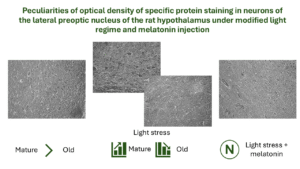2025 vol 4 issue 2
Full paper
Roman Bulyk 1, Vladyslav Yosypenko 1 *, Yuliana Yosypenko 2, Kateryna Vlasova 1, Mariana Kryvchanska 1, Oleksij Smetaniuk 1, Alla Velyka 3
1 Department of Medical Biology and Genetics, Bukovinian State Medical University
2 Department of Chemistry and Food Products Expertise, Yuriy Fedkovych Chernivtsi National University
3 Department of Medical and Pharmaceutical Chemistry, Bukovinian State Medical University
* Correspondence to: v.yosypenko@bsmu.edu.ua
pp. 157-168
DOI: 10.58332/scirad2025v4i2a03
Abstract
 This study investigated the effect of melatonin on protein accumulation in neurons of the lateral preoptic nucleus (LPN) of the rat hypothalamus under different light conditions. Using bromophenol blue histochemical staining, we analyzed protein synthesis in mature and old rats exposed to standard lighting, continuous light, and continuous light with melatonin administration. Continuous light exposure led to age-dependent effects: in mature rats, protein accumulation slightly increased, suggesting an adaptive response, whereas in old rats, it decreased significantly. Melatonin administration under constant light normalized protein synthesis in mature rats and partially restored it in old animals. These findings highlight the modulatory role of melatonin on circadian rhythm disturbances and age-related impairments in neuronal metabolism. Although direct markers of cellular stress were not measured, the observed changes in protein synthesis may reflect altered neuronal activity and metabolic stress under continuous light exposure. Melatonin may thus offer neuroprotective benefits by supporting protein homeostasis in light-induced circadian disruption.
This study investigated the effect of melatonin on protein accumulation in neurons of the lateral preoptic nucleus (LPN) of the rat hypothalamus under different light conditions. Using bromophenol blue histochemical staining, we analyzed protein synthesis in mature and old rats exposed to standard lighting, continuous light, and continuous light with melatonin administration. Continuous light exposure led to age-dependent effects: in mature rats, protein accumulation slightly increased, suggesting an adaptive response, whereas in old rats, it decreased significantly. Melatonin administration under constant light normalized protein synthesis in mature rats and partially restored it in old animals. These findings highlight the modulatory role of melatonin on circadian rhythm disturbances and age-related impairments in neuronal metabolism. Although direct markers of cellular stress were not measured, the observed changes in protein synthesis may reflect altered neuronal activity and metabolic stress under continuous light exposure. Melatonin may thus offer neuroprotective benefits by supporting protein homeostasis in light-induced circadian disruption.
Keywords
melatonin, circadian rhythms, neuroprotection, light stress, hypothalamic neurons, neuronal metabolism, molecular biology
First published: 16.06.2025
